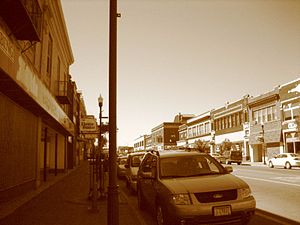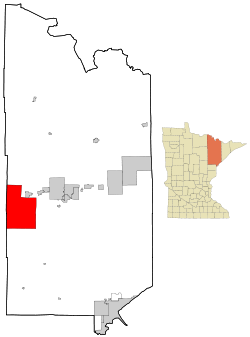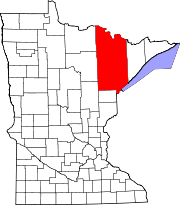- Hibbing, Minnesota
-
Hibbing, Minnesota — City — Location of the city of Hibbing in Saint Louis County, Minnesota Coordinates: 47°25′2″N 92°56′18″W / 47.41722°N 92.93833°W Country United States State Minnesota County Saint Louis Government – Mayor Rick Cannata Area – Total 186.5 sq mi (483.1 km2) – Land 181.7 sq mi (470.5 km2) – Water 4.8 sq mi (12.5 km2) Elevation 1,493 ft (455 m) Population (2010)[1] – Total 16,361 – Density 94.0/sq mi (36.3/km2) Time zone Central (CST) (UTC-6) – Summer (DST) CDT (UTC-5) ZIP codes 55746 Area code(s) 218 FIPS code 27-28790[2] GNIS feature ID 0661469[3] Website www.hibbing.mn.us Hibbing is a city in Saint Louis County, Minnesota, United States. The population was 16,361 at the 2010 census.[1] The city was built on the rich iron ore of the Mesabi Iron Range. At the edge of town is the largest open-pit iron mine in the world.[4] U.S. Highway 169, State Highway 37, and State Highway 73 are three of the main arterial routes in the city.
Contents
History
Hibbing was originally four separate communities (from north to south): Village of Hibbing, Village of South Hibbing, Village of Alice and Village of Hibbing Heights.
Hibbing was founded in 1893 by the town's namesake, Frank Hibbing.[5] Hibbing was born in Hannover, Germany on December 1, 1856 and was christened Frans Dietrich von Ahlen. His mother died when he was still in infancy and it was her name, Hibbing, which he assumed when he set out to seek his fortune in the New World. He first settled in Beaver Dam, Wisconsin where he worked on a farm and in a shingle mill. After deciding he was not familiar enough with the English language to make a legal career possible, he turned to timber cruising.
In 1887, Mr. Hibbing settled in Duluth where he established a real estate business and began explorations on the Vermilion Range. In 1892, he headed a party of thirty men at Mountain Iron and cut a road through the wilderness to Section 22, 58-20. An expert iron ore prospector, he soon discovered the surface indication which led him to believe in the existence of extensive ore deposits.
In July 1893, the townsite of Hibbing was laid out and named in honor of him. Feeling personally responsible as Hibbing's creator, he took deepest pride in its development and by his generous aid made its progress possible. He used his personal means to provide a water plant, electric light plant, the first roads, hotel, sawmill and bank building. For the last ten years of his life, Mr. Hibbing made his home in Duluth where many of his business interests were centered. He retained close contact with the community which bore his name, until he died of appendicitis on July 30, 1897 at age forty.
In 1914 two men, Carl Wickman and Andrew "Bus Andy" Anderson, started a bus line between Hibbing and Alice, Minnesota which would eventually become Greyhound Lines, the world's largest bus company.
Hibbing Heights was platted in 1908, which was annexed by Alice in 1910, when Alice incorporated as a city. Between 1919 and 1921, Village of Hibbing relocated immediately south of Alice, and then annexed Alice, becoming the City of Hibbing.
Hibbing is the home to the world's largest iron ore mine, which was discovered by Leonidas Merritt. Hibbing grew rapidly in its early years as the huge iron ore mines such as the Mahoning, Hull Rust, Sellers and Burt provided the raw material for America's industrial revolution. In fact, the mines encroached on the village from the east, north and south and it was determined that some of the ore body actually went under the town whose population had hit 20,000 by 1915.
Negotiations between the Oliver Mining Company and the village finally brought about a plan whereby the entire village would relocate to a site two miles south near Alice. The company, for its part, agreed to develop the downtown buildings with low interest loans that could be paid off over the years by the retailers. New civic structures such as Hibbing High School, the Androy Hotel, the Village Hall and the Rood Hospital were also constructed with mining company money. In all, about 200 structures were moved down the First Avenue Highway, as it was called, to the new city. These included a store and even a couple of large hotels. Only one structure didn't make it. A hotel tumbled off the rollers and crashed to the ground leaving, as one witness said, "an enormous pile of kindling". The move started in 1919, and the first phase was completed in 1921. South Hibbing, known today as the neighborhood of North Hibbing, remained as a business and residential center through the 1930s when the mining companies bought the remaining structures. The last house was moved in 1968.[6]
On July 25, 1979, Hibbing annexed Stuntz Township. With this annexation, the following unincorporated communities in Stuntz Township were also annexed (community location by township, range and section indicated):
- Brooklyn (T57N, R20W, Section 6)
- Burton (T57N, R20W, Section 8)
- Darrow (T56N, R20W, Section 31)
- Dunwoody Junction (T57N, R20W, Section 3)
- Frederick (T56N, R20W, Section 18)
- Kelly Lake (T57N, R21W, Sections 16 and 21)
- Kerr (T57N, R21W, Section 14)
- Kitzville (T57N, R20W, Section 5)
- Lavinia (T58N, R21W, Section 25)
- Leetonia (T57N, R21W, Section 15)
- Leighton (T56N, R21W, Section 9)
- Little Swan (T56N, R20W, intersection of Sections 25, 26, 35 and 36)
- Mahoning (T57N, R21W, Section 2)
- Mitchell (T57N, R20W, Section 4)
- Onega (or Omega in some documents) (T56N, R20W, Section 24)
- Powers (T58N, R21W, Section 23)
- Redore (T57N, R20W, Section 5)
- Riley (T56N, R21W, Section 1)
- Ruby Junction (T57N, R20W, Section 7)
- Scranton (T57N, R21W, Section 13)
- Sims (T56N, R21W, Section 16)
- Stevenson (or Stephenson in some documents) (T58N, R21W, Section 7)
- Stuart (T56N, R21W, Section 29)
- Wilpen (T57N, R20W, Section 2)
Geography
According to the United States Census Bureau, the city has a total area of 186.5 square miles (483 km2) and is the largest city in Minnesota by area and the 40th largest city, by area, in the United States. 181.7 square miles (471 km2) of it is land and 4.8 square miles (12 km2) of it (2.60%) is water. McCarthy Beach State Park is nearby.
The Northern Divide intersects the Eastern Continental Divide near Hibbing, with waters draining to the Arctic Ocean, the Gulf of Mexico and the Great Lakes.[7]
Demographics
Historical populations Census Pop. %± 1900 2,481 — 1910 8,832 256.0% 1920 15,089 70.8% 1930 15,666 3.8% 1940 16,385 4.6% 1950 16,276 −0.7% 1960 17,731 8.9% 1970 20,744 17.0% 1980 21,193 2.2% 1990 18,046 −14.8% 2000 17,071 −5.4% 2010 16,361 −4.2% U.S. Decennial Census As of the census[2] of 2000, there were 17,071 people, 7,439 households, and 4,597 families residing in the city. The population density was 94.0 people per square mile (36.3/km²). There were 8,037 housing units at an average density of 44.2 per square mile (17.1/km²). The racial makeup of the city was 97.33% White, 0.46% Black, 0.73% Native American, 0.27% Asian, 0.01% Pacific Islander, 0.19% from other races, and 1.01% from two or more races. Hispanic or Latino of any race were 0.68% of the population. 17.1% were of German, 12.4% Finnish, 10.5% Norwegian, 9.4% Italian, 6.4% Irish and 5.9% Swedish ancestry according to Census 2000.
There were 7,439 households out of which 27.7% had children under the age of 18 living with them, 48.3% were married couples living together, 9.6% had a female householder with no husband present, and 38.2% were non-families. 33.5% of all households were made up of individuals and 15.5% had someone living alone who was 65 years of age or older. The average household size was 2.24 and the average family size was 2.86.
In the city the population was spread out with 22.8% under the age of 18, 9.1% from 18 to 24, 24.5% from 25 to 44, 23.8% from 45 to 64, and 19.8% who were 65 years of age or older. The median age was 41 years. For every 100 females there were 93.1 males. For every 100 females age 18 and over, there were 89.4 males.
The median income for a household in the city was $33,346, and the median income for a family was $43,558. Males had a median income of $38,064 versus $22,183 for females. The per capita income for the city was $18,561. About 8.1% of families and 11.7% of the population were below the poverty line, including 16.3% of those under age 18 and 8.2% of those age 65 or over.
Notable natives and residents
- Joe Bretto, professional hockey player, Chicago Black Hawks.
- Vincent Bugliosi, prosecutor of Charles Manson.
- Bruce Carlson, United States Air Force general, director of the National Reconnaissance Office.
- Steve Deger, nonfiction author.
- Bob Dylan (born Robert Zimmerman in Duluth), musician, singer-songwriter, Rock and Roll Hall of Famer and Pulitzer Prize winner.
- Steve Enich, professional football player.
- Dick Garmaker, professional basketball player.
- Gus Hall, former leader of the Communist Party USA and four-time U.S. presidential candidate.
- Jeff Halper, professor of anthropology, author, lecturer, political activist and co-founder of Israeli Committee Against House Demolitions.
- Chi Chi LaRue, American film director
- Roger Maris, professional baseball player, former single-season homerun record holder.
- Kevin McHale, professional basketball player, 3 NBA titles with the Boston Celtics, former Minnesota Timberwolves Vice President. Current coach of Houston Rockets.
- Bethany McLean, co-author of Enron: The Smartest Guys in the Room.
- Joe Micheletti, professional hockey player, television Olympics & NHL hockey analyst in NYC.
- Pat Micheletti, professional hockey player.
- Robert Mondavi, American wine entrepreneur.
- Marie Myung-Ok Lee, novelist and essayist.
- Carol J. Oja, music historian at Harvard University.
- Jeno Paulucci, founder of Jeno's Pizza and Chun King Foods brands
- Rudy Perpich, Minnesota governor, former town dentist
- Gary Puckett, musician.
- Jay Thomas, Radio talk show host on WDAY (AM).
- Carl Wickman, founder and longtime CEO of Greyhound Lines.
Radio stations
Hibbing is home to six stations, all owned by Midwest Communications; KMFG, WMFG, WMFG-FM, WNMT, WTBX, WUSZ. All the stations share the same studio location at 807 W. 37th Street, Hibbing.
Sister cities
Hibbing has one sister city:
See also
- Hibbing Community College – HCC
- WNMT – Local talk radio show
- U.S. Highway 169
- State Highway 37
- State Highway 73
- Greyhound Bus Museum
External links
- City of Hibbing – Official Website
- Hibbing Public Library website
- Hibbing Chamber of Commerce
- Greyhound Bus Museum
- 1987 Photos of Bob Dylan's hometown — a personal photo journal by two Dylan fans who spent the day in Hibbing, Minnesota.
References
- ^ a b "2010 Census Redistricting Data (Public Law 94-171) Summary File". American FactFinder. U.S. Census Bureau, 2010 Census. http://factfinder2.census.gov/faces/tableservices/jsf/pages/productview.xhtml?pid=DEC_10_PL_GCTPL2.ST13&prodType=table. Retrieved 23 April 2011.
- ^ a b "American FactFinder". United States Census Bureau. http://factfinder.census.gov. Retrieved 2008-01-31.
- ^ "US Board on Geographic Names". United States Geological Survey. 2007-10-25. http://geonames.usgs.gov. Retrieved 2008-01-31.
- ^ Gilman, Rhoda R. (1989). The Story of Minnesota's Past. Saint Paul, Minnesota: Minnesota Historical Society Press. pp. 35–43. ISBN 0-87351-267-7.
- ^ http://www.hibbing.mn.us/
- ^ Hibbing: The Town That Moved, accessed 2011 March 16.
- ^ "Minnesota State Map Collection". Geology.com. 2006. http://geology.com/state-map/minnesota.shtml. Retrieved 2007-12-29.
- ^ "Sister Cities in our Region". U.S. Consulate General Hamburg, Germany. http://hamburg.usconsulate.gov/hamburg/sister_cities.html. Retrieved 16 January 2010.
- ^ "LOWER SAXONY AND THE UNITED STATES". U.S. Consulate General Hamburg. August 2009. pp. 3. http://germany.usembassy.gov/root/pdfs/policy/lowersax_aug09.pdf. Retrieved 16 January 2010.[dead link]
 State of Minnesota
State of MinnesotaTopics - Index
- Cities
- Climate
- Colleges and universities
- Congressional districts
- Demographics
- Ecology
- Economy
- Geography
- Geology
- Governors
- High schools
- Historical Congressional delegations
- Historical Landmarks
- History
- Lakes
- Movies and television
- Music
- People
- Political parties
- Rivers
- School districts
- Scouting
- Sports
- State fair
- State parks
- Territory
- Townships
- Transportation
- Visitor Attractions
Regions Larger cities
pop. over 60,000Smaller cities
pop. over 10,000- Albert Lea
- Alexandria
- Andover
- Anoka
- Apple Valley
- Austin
- Bemidji
- Big Lake
- Blaine
- Brainerd
- Brooklyn Center
- Buffalo
- Champlin
- Chanhassen
- Chaska
- Cloquet
- Columbia Heights
- Cottage Grove
- Crystal
- East Bethel
- Edina
- Elk River
- Fairmont
- Faribault
- Farmington
- Fergus Falls
- Forest Lake
- Fridley
- Golden Valley
- Grand Rapids
- Ham Lake
- Hastings
- Hibbing
- Hopkins
- Hugo
- Hutchinson
- Inver Grove Heights
- Lakeville
- Lino Lakes
- Mankato
- Maplewood
- Marshall
- Mendota Heights
- Minnetonka
- Monticello
- Moorhead
- Mounds View
- New Brighton
- New Hope
- New Ulm
- North Branch
- North Mankato
- North St. Paul
- Northfield
- Oakdale
- Otsego
- Owatonna
- Prior Lake
- Ramsey
- Red Wing
- Richfield
- Robbinsdale
- Rosemount
- Roseville
- Sartell
- Sauk Rapids
- Savage
- Shakopee
- Shoreview
- South St. Paul
- St. Louis Park
- St. Michael
- St. Peter
- Stillwater
- Vadnais Heights
- Waconia
- West St. Paul
- White Bear Lake
- Willmar
- Winona
- Worthington
Counties - Aitkin
- Anoka
- Becker
- Beltrami
- Benton
- Big Stone
- Blue Earth
- Brown
- Carlton
- Carver
- Cass
- Chippewa
- Chisago
- Clay
- Clearwater
- Cook
- Cottonwood
- Crow Wing
- Dakota
- Dodge
- Douglas
- Faribault
- Fillmore
- Freeborn
- Goodhue
- Grant
- Hennepin
- Houston
- Hubbard
- Isanti
- Itasca
- Jackson
- Kanabec
- Kandiyohi
- Kittson
- Koochiching
- Lac qui Parle
- Lake
- Lake of the Woods
- Le Sueur
- Lincoln
- Lyon
- Mahnomen
- Marshall
- Martin
- McLeod
- Meeker
- Mille Lacs
- Morrison
- Mower
- Murray
- Nicollet
- Nobles
- Norman
- Olmsted
- Otter Tail
- Pennington
- Pine
- Pipestone
- Polk
- Pope
- Ramsey
- Red Lake
- Redwood
- Renville
- Rice
- Rock
- Roseau
- St. Louis
- Scott
- Sherburne
- Sibley
- Stearns
- Steele
- Stevens
- Swift
- Todd
- Traverse
- Wabasha
- Wadena
- Waseca
- Washington
- Watonwan
- Wilkin
- Winona
- Wright
- Yellow Medicine
Coordinates: 47°25′38″N 92°56′16″W / 47.42722°N 92.93778°W
Categories:- Bob Dylan
- Cities in Minnesota
- Mining communities in Minnesota
- Populated places established in 1893
- Populated places in St. Louis County, Minnesota
Wikimedia Foundation. 2010.



